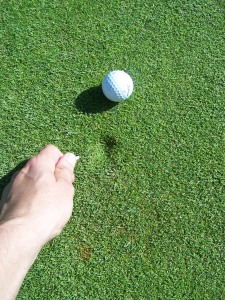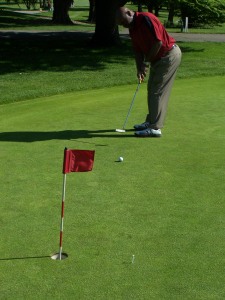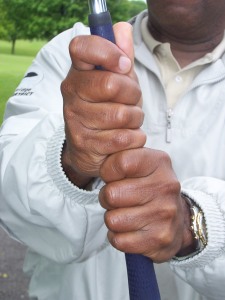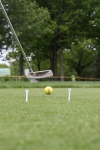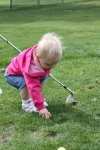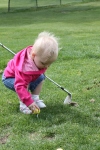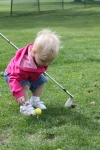
Mark Tolle is the owner of Chicago Golf Fitness. He has over 18 years of experience in athletic training, rehabilitation and fitness. He prides himself on being up to date with the most current fitness techniques and training. Mark uses an individualized program for each client and his goal is to assess problems and improve function. I recently had the opportunity to interview Mark about some ways you can use fitness to improve your game.
Q: In your experience, what are the most common deficiencies or limitations you witness in the average golfer that has the greatest influence on keeping them from optimal performance?
A: The most common physical limitation in an average golfer that I see has to do with mobility and flexibility in the upper back and hips. It is very important to have good mobility and flexibility in both of these areas. Mobility and flexibility technically refer to 2 different things, so often times the approach to improve both are a little different. A key point to recognize is that it’s not all about stretching.
The upper back (thoracic spine) is designed to rotate and if you have restriction in that area, your shoulder turn in the golf swing will be limited. One of the key factors in a good shoulder turn is posture, as well. So if you have poor upper back posture (curve forward in set up) it is more difficult for the spine to rotate as needed in the swing. Then what happens when you go into your backswing is your body tries to get the needed rotation from somewhere else and creates compensations. The one significant compensation that occurs is over rotation through the low back (lumbar spine). This leads to back pain because the low back is not made to rotate like the upper back. Then of course you don’t perform a good fundamentally sound swing.
Mobility and flexibility in the hips is also a common limitation I find. I actually measure the range of motion in the hip and find that internal rotation is often times very limited. If this occurs on the backside hip it limits a good hip turn and can again lead to compensations elsewhere such as the low back, as well as changes in the spine angle of the golf swing.
Every golfer that wants to improve their game needs to have these 2 areas assessed, and if limitations are found, work hard to improve them.
Q: Everyone likes to hit the ball further…what are a couple of the methods or recommendations you use to get your clients to achieve greater clubhead speed and power?
A: Club head speed and power in the golf swing is created by a combination of factors. I think of the golf swing as a sequence of loading and unloading of body parts. I always think back to an educational seminar on golf and fitness I attended. I remember there was an individual also in attendance that had a background in physics and biomechanics. She wasn’t a golf or fitness professional and didn’t really play the game. However she understood the swing and could break it down and explain it with the best of them. My point being is a good golf swing is dependent upon efficient use of the levers in the body, and control of the forces that are generated in the swinging motion.
Often times the golf swing and its power development has been described as a whip. In other words, the club head speed at impact is like the powerful crack of a whip. You load the whip with the motion of the shoulder, arm and hand, and it transfers to the tip at impact. A similar thing happens with the golf swing. So to achieve greater club head speed you need efficient use of the levers (mobility/flexibility) and control of forces (stability) that pass through to the club head at impact.
One of my obligations as a golf fitness professional is to aid the golf professional by helping his student have the mobility/flexibility to load the sequence of the golf swing and the stability to control the forces so they can be transferred out to the club head.
The way I help create more power in the golf swing is to work with the teaching professional so that I can improve the golfer’s mobility where it is needed. That way the professional is able to put the golfer in better positions in the golf swing. Also I improve pelvic/core stability so that they can then control and transfer more power to the club at impact.
Q: If someone is already engaged in a ‘typical’ fitness routine at the gym (for instance, use of cardio equipment like a treadmill, typical exercises and lifts with weights like bench presses, curls, and squats, etc.), what are the major components of a ‘golf-specific’ training program that they are still lacking? What makes your program(s) different than the advice they might find in a typical mens or womens fitness magazine?
A: I look at fitness and performance from 2 different perspectives. First, and generally speaking, there are many people’s lives that can be improved and in many ways, by just becoming more fit. I know that by just losing weight, becoming stronger or more flexible, they will feel better be healthier and play better golf. I always support any kind exercise over nothing.
However, by using a fitness or sport specific coach your results are going to be better and longer lasting. I often times use the phrase, “if you layer fitness on top of dysfunction the body will eventually give out”. What this means is, if you just exercise with all disregard for how your body functions your performance will suffer and your body will give out. You need to make sure you have good posture. You need to make sure the right muscles are doing the right job (no compensations). You need to make sure your joints have good mobility. These and many other reasons justify the use of some type of fitness coaching.
With my golf specific training, I provide an in depth functional movement screen, an injury prevention screen as well as a golf specific analysis. I always speak with the teaching professional if they have one, and if they don’t I recommend one. What this does is give me a clear path as to what needs to be worked on. Swing faults many times have physical limitations as a cause. So watching a lesson, and speaking with the teaching professional ensures a team approach to golf performance. Even though there are many good tips in magazines or floating around online, you truly benefit to a higher degree with this type of personal team approach. Everyone is different, so general training may often times be a waste of time if you are looking for improvements in your game.
Q: Obviously, everyone is unique. But, on average, what do you think the typical woman needs to focus on as it relates to golf specific training? What does the average man need to focus on?
A: When training women golfers I take the same approach when performing the physical screens. That way I still can know what the biggest roadblocks are to acquiring an improved game. Typically women need to work more on strength in the upper body, trunk and legs. Getting stronger can do wonders for a women’s golf game. They tend to have pretty good mobility, however they have trouble controlling that mobility. So strength and stability is an important factor for women.
Men on the other hand tend to have mobility/flexibility and posture issues. A good mobility program for the upper back & hips can make a big difference in their golf swing and game.
Q: What are some of the results, both in terms of golf and overall lifestyle improvements, have you witnessed as a result of following your programs and utilizing your training? Is it really possible to improve your golf game by improving your physical abilities?
A: It has been a great pleasure to work with golfers. I’m always grateful to have the opportunity to help out fellow golfers, and anyone that wants to improve their lives. I have had golfers lose weight and be able to walk a golf course, where they couldn’t before. I worked in outpatient rehabilitation for 15 years and was able to help many injured golfers return to playing. Many golfers hit the ball further and generally play better. I have helped golfers with back pain get back on the course and even lower their handicap. I especially enjoy working with the golf professional in a team approach to help take golfers to the next level. I often feel as if I have a moral obligation to reach out and help as many people as possible improve their lives.
I not only believe it is possible to improve your golf game with fitness, but I think it should become the norm for golf schools, golf academies and all golfers. Not only for the “Good Of The Game” but for the “Good Of Our Bodies”
Q: I’m sure several of our golfers will be ready to start a golf fitness program after hearing your answers here. How can golfers contact you for further information?
A: I can be reached by telephone at 773-965-4959 or e-mail at mark@chicagogolftrainer.com. I also have a website and blog that provides additional information that can help with any questions. I do offer free, no obligation consultations where golfers can meet me and find out how they can improve their individual game. Also I have an e-mail newsletter people can sign up for. I can be followed on twitter at “golffit” as well.


